#the overstreet comic book price guide
Photo
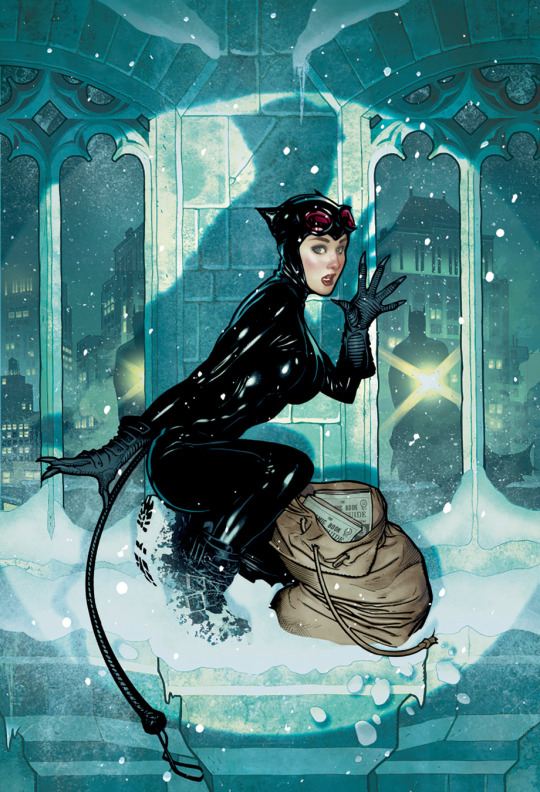
'Catwoman' by Adam Hughes.
Variant cover art for 'The Overstreet Comic Book Price Guide' 42nd edition, published July 2012.
#Art Of The Day#Art#AOTD#Adam Hughes#Catwoman#The Overstreet Comic Book Price Guide#Comics#Comic Art#Comic Cover#Comic Cover Art#Cover Art#Variant Cover#Female#Feminine#Pinup
121 notes
·
View notes
Text


Alex Schomburg - Overstreet Comic Book Price Guide #10 Cover Featuring Captain America, The Human Torch, And The Sub-Mariner Original Art (1980)
7 notes
·
View notes
Text

The Overstreet Comic Book Price Guide #52 2022-2023, Bill Gaines 100th Anniversary variant cover by Aaron Lopresti
#Comics#EC#Horror host#Crypt Keeper#Vault Keeper#Old Witch#Aaron Lopresti#Bill Gaines#Overstreet Comic Book Price Guide
19 notes
·
View notes
Text
Big, Big Overstreet #52 Sold Out!
ICC Magazine’s full-page ad is on Page 238 of Overstreet Comic Books Price Guide #52!
The Big, Big Overstreet Comic Book Price Guide #52 has sold out through Diamond Comic Distributors and through the Gemstone Publishing webstore. The Big, Big version of the Guide is a larger format, limited print run that went on sale just two weeks ago on Wednesday, July 20, 2022.
The Big, Big Guide features…

View On WordPress
0 notes
Photo
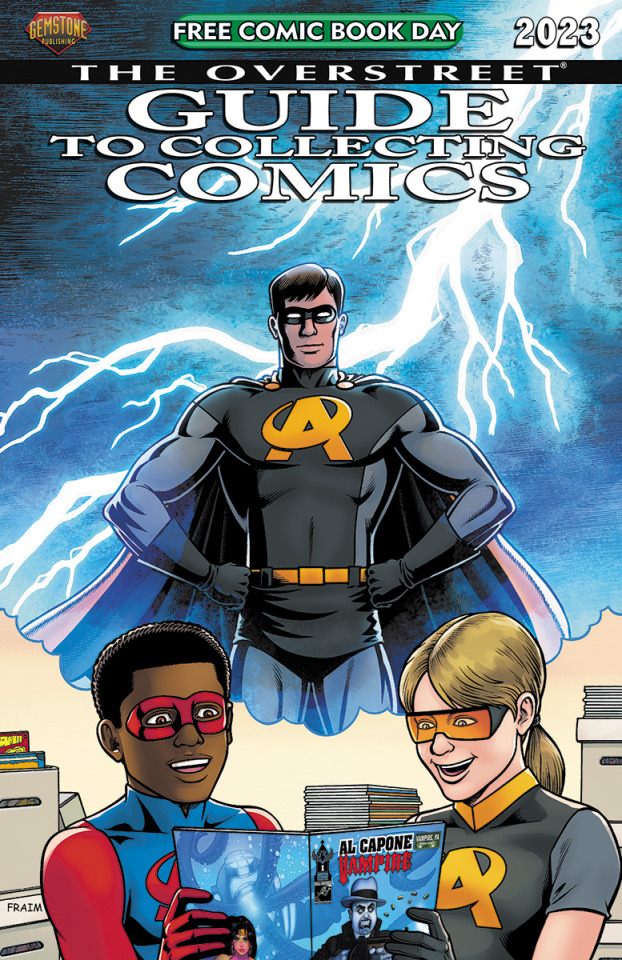
The Overstreet Guide to Collecting Comics is one of more than 40 comics being offered for Free Comic Book Day 2023 on May 6. See what else is arriving on Free Comic Book Day 2023.
#overstreet comic book price guide#the overstreet guide to collecting comics#comics#comic books#fcbd 2023#free comic book day
0 notes
Text
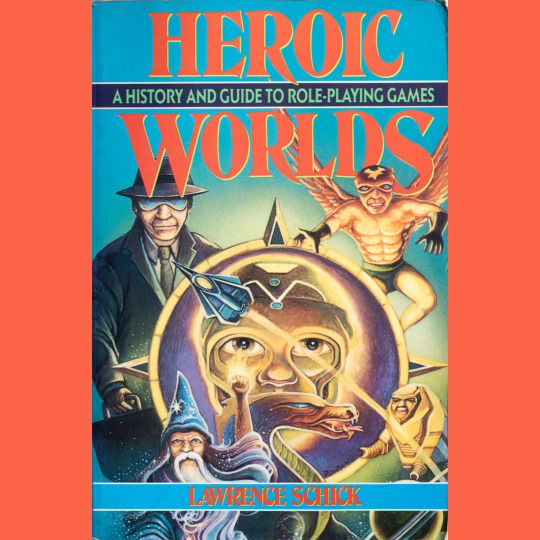
This is Heroic Worlds (1991), by Lawrence Schick (of White Plume Mountain fame).
There are a bunch of books from the ‘80s and ‘90s that attempt to catalog and review RPGs and they kind of boggle my mind (the same is true for the similar genre of print paperback tip guides for videogame). Even having lived in the pre-internet era, I don’t understand the rationale for these books from a publishing perspective. Which is not to say I don’t adore Heroic Worlds. I do! It just seems…improbable.
The book essentially amounts to an index of every RPG product produced from 1974 to 1990. It feels a tiny bit like an Overstreet Comic Book Price Guide (another publication I’ve always been baffled by), except without the prices (though there is a small section on collecting — the advice still rings true today, primarily: be patient!). The listings are interrupted periodically with short essays by a rogues gallery of RPG designers: Gary Gygax, Dave Arneson, Greg Stafford, Steve Jackson, Jennell Jaquays, Michael Stackpole, Ken St. Andre, Tom Moldvay, Ken Rolston, Sandy Petersen, Erick Wujcik, B. Dennis Sustare, N. Robin Crossby and Greg Gordon. That is a pretty all-star cast of characters talking about tabletop game design!
The main attraction for me, though, is Schick’s commentary. Nearly all of the listings are accompanied by very brief appraisals; they give Robert Christgau’s album reviews a run for their terseness. Schick has a dry wit that creeps into the capsule reviews that soon becomes addictive. And there is just something wonderful about having a period of time captured so exhaustively in a single volume. I don’t think EVERYTHING ever published through 1990 is in the index, but Schick sure makes the book feel like it does. I refer to it constantly for my Instagram posts, it was a constant companion when writing my own book and honestly, it deserves a lot of blame for the size and scope of my collection. Damn you, Schick!
(Repost from April 30, 2020; revised)
58 notes
·
View notes
Photo
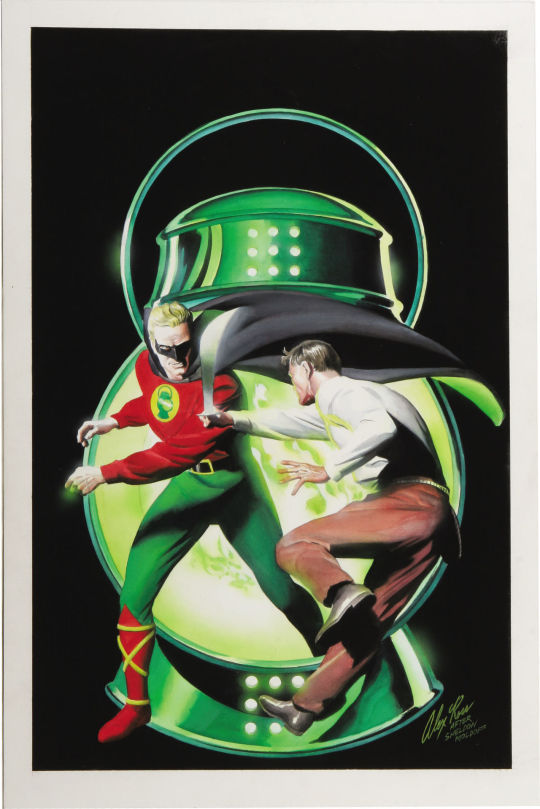
Alex Ross’ recreation of the cover for Green Lantern (vol. 1) #1 (September, 1941) by Sheldon Moldoff. This painting was used as a cover for the The Overstreet Comic Book Price Guide #27 (1997).
63 notes
·
View notes
Text

Adventure Comics #247, by Alex Ross (after Curt Swan & Stan Kaye)
Cover art for The Overstreet Comic Book Price Guide #29 (1999)
2 notes
·
View notes
Photo

WELCOME TO OUR THIRD ANNUAL COMIX OF THE YEAR SHOWCASE!
Boy, what a year it’s been for comics! I’ve read 126 completed series this year (with a grand total of 313 series over all, and that’s not counting single issues or currently ongoing series!) and I’ve come to actually own 558 physical single issues!
If last year I talked about falling deeper in love with the medium, then this year I’ve dedicated myself to learning its history by getting into books & magazines about comics -- the (presently available) entirety of Alter Ego, Back Issue!, Comic Book Creator/Artist, All-Star Companion Vol. 1-3, The Golden Age of Comic Fandom and Our Artists at War have been some of my favourite things to read this year and they haven’t made this list solely because I’m talking comics and only comics, but please know they’ve meant a great deal to me and have already influenced me deeply and contributed to the kind of reader/fan I’ve become and would like to continue being. Hell, I’ve even gotten to experience the once-unthinkable honour of writing for Back Issue! and interviewing some of my heroes!
And speaking of once-unthinkable things, the fact that we’ve gotten a total of three JSA books complete with an ongoing this year? I don’t even have words for what that means to me! Suffice to say, it’s been THE year of comics as far as I’m concerned. So, without further ado, here’s our winners:
The New Golden Age (2022)
It’s a one-shot but my god, what a one-shot it is! This book is what every longtime fan of the original Justice Society of America has dreamed of for decades, eager to acknowledge the team’s entire history across the years and its significance along with adding something new and exciting to the old and revered. I cried reading this, which is admittedly true for most things I love, but it’s a book like this that illustrates perfectly what the Overstreet Comic Book Price Guide had meant in 1995 when they’d called the creation of the team second only to the invention of the superhero. I can’t think of a more beautiful way to announce the coming of a new JSA era!
Doomsday Clock (2017)
A very take-it-or-leave-it kinda book, I know, and the intensity with which I came to love Doomsday Clock was a surprise even to myself but I genuinely believe it’s the series of the past decade. End of. It takes a special kind of fan to love what it says and does and means but a story about grief and love and legacy, a story that’s in effect about comic book history, that puts the JSA -- Alan Scott, specifically -- at its centre? You know I’m gonna be there. The ending in particular made me sob like no comic ever has before and when Jon understood Superman’s true purpose, I finally did too. “The rocket arrives. A child is loved. Superman is made.” That changed it all for me. I think Doomsday is also one of those rare books where a happy ending is a legitimately daring narrative choice, and the risk is more than worth it. One last stray thought to finish up this section: I’ve legitimately never found a more frighteningly real, deliciously well-written gay story in comics like Carver Colman’s entire arc here.
Before Watchmen: Minutemen (2012)
Minutemen’s a book that likes to linger in its hurt, like pressing on a bruise for the hell of it and sitting with the ache. We know the outcome from the very first page, and Darwyn Cooke’s art is as melancholy as his writing. I’ve come back to this one again and again, sometimes just to look at it. As a Golden Age of Comics lover and enjoyer, the tragedy (the shipwreck!) of the Minutemen is precisely what I’ve always understood as implicit to the JSA and to see it all spelled out made it an absolute favourite in an instant.
Watchmen (1986)
Hey, this list’s already dominated by Watchmen-adjacent books so, why not the original? My first thought upon finishing it was that the hype had been real this whole time and I couldn’t believe I’d lived my life blissfully unaware of everything this book has to offer. It’s still timeless, it still hits hard and it’s still a testament to the kind of love for comics that Alan Moore will never again show (and that Geoff Johns followed up perfectly in Doomsday Clock despite what you might’ve heard, after all at the core of Watchmen lies a truly encyclopedic knowledge of comic books and that’s a thing born out of love alone). All that being said, it ranks where it does because what’s always interested me in Watchmen has been the shadow of the story underneath the story, that of the Minutemen.
Nathaniel Dusk (1984)/Nathaniel Dusk II (1985)
The quintessential film noir, in comic book form. Gene Colan’s art makes the miniseries but Dusk is a truly unique outing no matter how you look at it, and its status as ostensibly set in the real world makes it all that more fascinating. Nathaniel Dusk is a hardboiled detective whose career is marred by too-personal tragedy, and the book’s custom-made for anybody’s who’s as big on character studies and character-driven pieces as I am.
Manhunter (1973)
There’s a lot that’s special about Archie Goodwin and Walt Simonson’s most enduring creation, there’s no doubt about that, but I loved Manhunter so much it gave way to something within me that I’ve genuinely never experienced before: the day after I finished reading it I went out and bought the hardcover, the week after that I got the action figure, and by now I���ve bought every single special or trade these Detective Comics (1937) #437-443 backups have ever been collected or appeared in. It’s a story that begs to be interacted with in some real tangible way, that’s all I can say! James Robinson spoke once about what a phenomenon this had been when it’d first came out -- with its then-novel use of ninjas, violence like something out of an exploitation film, the very serious matter of a man killing to regain his identity (his soul!) and ultimately dying having done so -- but there’s no denying the impact hasn’t lessened any. Among the comics of any era, Manhunter is a stark outlier and a necessary breath of fresh air.
Flashpoint Beyond (2022)
This little series somehow manages to outshine the event of the summer and just about all that’s followed it. Ostensibly a tie-in to Dark Crisis and theoretically bridging the gap between Doomsday Clock and The New Golden Age (year of Geoff Johns anyone?), what Flashpoint Beyond really is beyond all the pretexts is a deep-dive into a deeply traumatized man’s psyche. The book’s primary conflict is man vs. narrative as Flashpoint Thomas fights and fights against the very story he’s in until he can’t anymore. He refuses to play the hero the inhabitants of the Flashpoint world expect him to be but his rallying cry of ‘nothing matters’ because he’s seen his life destroyed twice over is ignored even by the story insisting him on placing him in the ill-fitting role of Batman, and the construction of this book is certainly something to see.
Cinder & Ashe (1988)
I’m a great big fan of character-driven pieces, as we already know, and an even bigger fan of standalone miniseries that you simply can’t put down, throw in Jose Luis Garcia-Lopez’s art in the mix and I’m unlikely to ever stop thinking about it. At its heart, Cinder & Ashe is a story about the Vietnam war but it’s also a harrowing mystery thriller set in New Orleans and an exploration of racism, the military complex, and two lives consumed by grief. There’s very little I can say that won’t spoil the story but it’s here for a reason and I’d be willing to call it a legitimate all-time favourite by now.
The Night Force (1982)
This is a real gem of DC’s horror/supernatural line and most certainly Marv Wolfman’s best work despite his decades in the business. A thoroughly entertaining and wildly compelling book, Night Force accomplishes the incredible feat of successfully balancing a main character that’s a complete enigma with a supporting cast of fallible all-too-human, all-too-real characters. If Baron Winters’ entry into the DC Universe at large is its most lasting impact, then Jack Gold is its true protagonist. As far as I’m concerned, there’s few sequences as sincerely terrifying and viscerally uncomfortable as the climax in issue #7 as Jack lies to save his life -- to save the world -- and the narration goes something like “He must spend a lifetime with this woman he does not care about. He does not love her, yet… yet there is that thing deep within Vanessa, that darkness that may again rise forth if she ever learned the truth. And Jack Gold cries. The horror is all his, the horror is all his.” I think about this so much and so often! For the obvious reasons, it’s quite possibly my favourite -- and one of the earliest -- gaycoded character arcs I’ve ever read.
Scribbly (1948)
I’m a humor book aficionado, I’m practically Keith Giffen’s #1 fan, I read Ambush Bug (& Son) every time I’m feeling down, I like to think I know my stuff from Sugar & Spike to Bizarro Comics and whatever else you’ve got but-- Shelly Mayer’s Scribbly is a revelation. The grandfather of all humor comics and first published in 1936 by Dell Comics ‘till his move to All-American and then the above solo at National Comics (a man of the world!), the eponymous boy cartoonist is Mayer’s autobiographical creation and makes for one of the most startlingly clever, laugh-out-loud funny books I’ve read in my entire life. Scribbly isn’t just a fascinating case study in where the majority of gags we now take of granted originated or likely the world’s first autobiographical comic strip, it’s also sincerely creative, shockingly modern and firmly in a class of its own!
SPECIAL MENTION
JSA: The Liberty File (2000)/JSA: The Unholy Three (2003)
Catwoman: Lonely City (2021)
Enemy Ace/Balloon Buster (assorted)
Vigilante: City Lights, Prairie Justice (1995)
Supergirl: Woman of Tomorrow (2021)
Human Target (2003)
Justice Society of America (2022)
Green Arrow (1983)
Adam Strange (1990)
Martian Manhunter: American Secrets (1992)
#THERES A LOT. AND I MEAN A /LOT/ THAT I LOVED AND DIDNT MAKE IT. BUT I TRIED TO LEAVE IT FOR A BEST OF THE BEST SORT OF DEAL#personal#comix of the year#dc#dc comics#u can rb
12 notes
·
View notes
Text
Gemstone Publishing moves into publishing graphic novels starting with Kill Shakespeare
Gemstone Publishing moves into publishing graphic novels starting with Kill Shakespeare #comics #comicbooks #graphicovel
For the first time in its history Gemstone Publishing, the publisher of The Overstreet Comic Book Price Guide, will publish graphic novels, beginning with Pulitzer Prize-Winning writer Anthony Del Col’s acclaimed series Kill Shakespeare. The publishing program begins on Free Comic Book Day, May 4, 2024 with the release of the first act of Romeo Vs. Juliet: A Kill Shakespeare Adventure. Del Col…
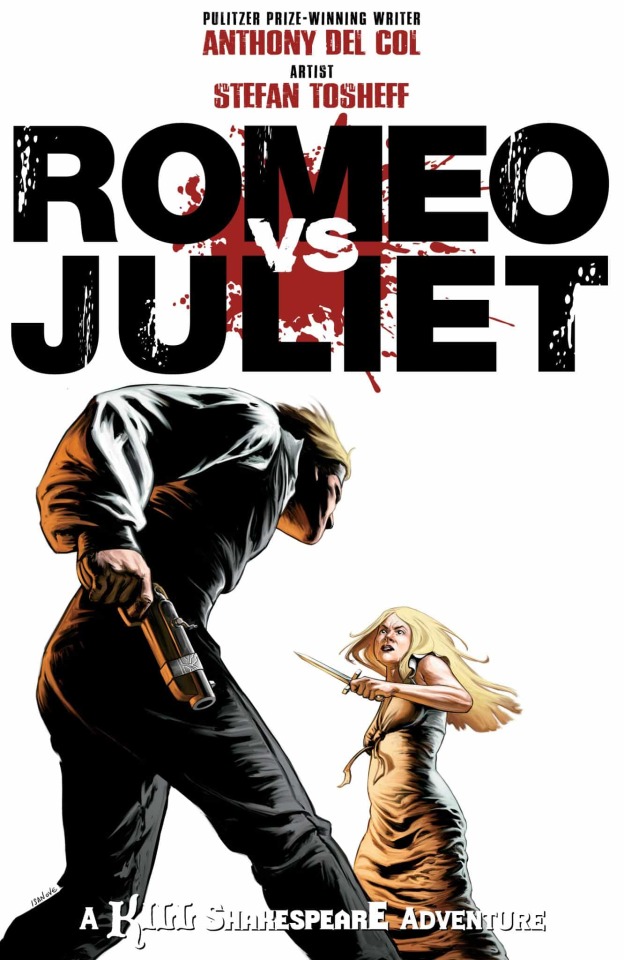
View On WordPress
#andy belanger#anthony del col#becca carey#comic books#Comics#conor mccreery#graphic novels#ian herring#kill shakespeare#richard isanove#romeo vs. juliet: a kill shakespeare adventure#stefan tosheff
0 notes
Text
Won't Get Rich Collecting Comics!
Read this great article and click on affiliate links below it.
But if folks would stop thinking comics are their highway to riches and just enjoy them, they’d be a lot calmer about the whole issue (pun intended).
But if folks would stop thinking comics are their highway to riches and just enjoy them, they’d be a lot calmer about the whole issue (pun intended).
A comic book is worth as much as collectors are willing to spend. The Overstreet Price Guide is…

View On WordPress
#collectors#comic books#comics#DC Comics#hobby#making money#Marvel Comics#nostalgia#overstreet#spiderman#stan lee
0 notes
Text
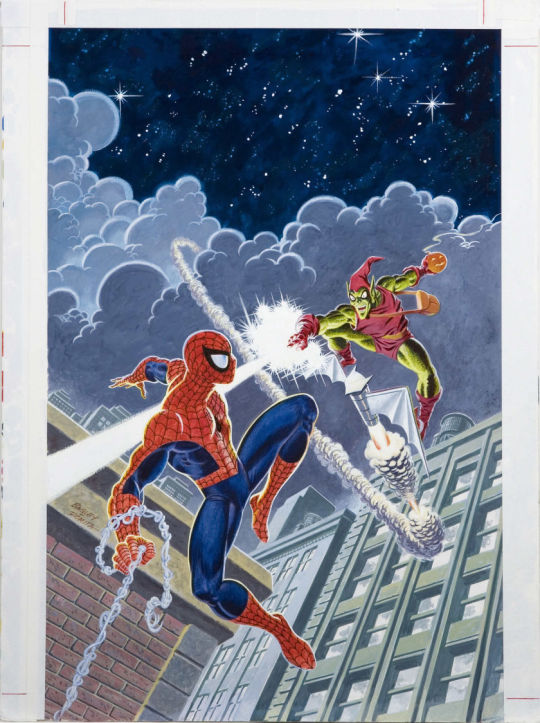
the cover to The Official Overstreet Comic Book Price Guide #22 by Mark Bagley and John Romita
0 notes
Text

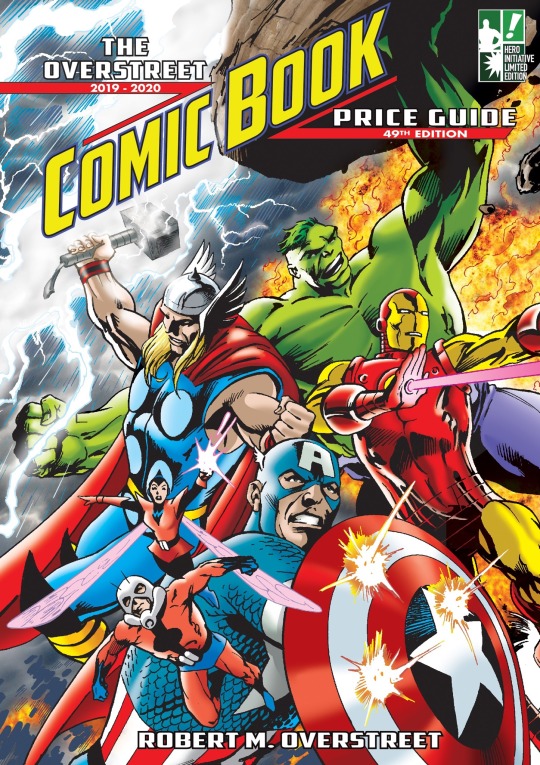
Alan Davis - Overstreet Comic Book Price Guide #49 Heroes Initiative Limited Edition (2019) feat. the original Avengers
Source, source
4 notes
·
View notes
Text
Amazing Spider-Man #28 CGC 2.0 1965 Marvel 1st App Molten Man

The Amazing Spider-Man #28 was published by Marvel Comics in September 1965. It is a significant issue in Spider-Man's history, written by Stan Lee and illustrated by Steve Ditko.
In this issue, Spider-Man faces off against the villain known as the Molten Man, who is actually Mark Raxton, a former employee of Oscorp. Raxton gains superhuman powers after accidentally exposing himself to an experimental liquid metal alloy. As the Molten Man, he seeks revenge on his former employer and clashes with Spider-Man throughout the issue.
The story also focuses on the personal life of Peter Parker (Spider-Man's alter ego) as he deals with the challenges of being a teenager and juggling his superhero responsibilities. It delves into his relationships with his Aunt May, his friend Harry Osborn, and his love interest Gwen Stacy.

Amazing Spider-Man #28 CGC 2.0 1965 Marvel 1st App Molten Man - Available NOW on eBay
Origin Story of Molten Man -- First Appearance in Amazing Spider-Man #28
The origin story of the Molten Man, also known as Mark Raxton, involves his transformation into a superhuman being due to exposure to an experimental liquid metal alloy. Here's a summary of his origin:
Mark Raxton was introduced as a scientist and a former employee of Oscorp, the company owned by Norman Osborn. Raxton's goal was to find a way to create a durable, super-strong alloy. During his research, he discovered a liquid metal formula created by Dr. Spencer Smythe. Intrigued by its potential, Raxton secretly stole the liquid metal alloy and performed an unauthorized experiment on himself.
The experiment, involving an intense exposure to the liquid metal alloy, caused a profound change in Raxton's physiology. The alloy bonded with his body, transforming him into a being with superhuman abilities. His entire body became covered in a molten metal-like substance, granting him increased strength, durability, and the ability to generate intense heat and molten metal from his body.
However, the transformation came at a cost. Raxton found himself trapped in a constant state of pain and unable to remove the molten metal substance covering his body. As a result, he became embittered and sought ways to alleviate his suffering, often resorting to criminal activities to fund his endeavors.
Driven by greed and a desire for power, the Molten Man clashed with Spider-Man on multiple occasions, often targeting valuable items or seeking revenge against those he believed wronged him.
GET ALL THE MOST CURRENT INFO ON THE BEST BOOKS - First Appearances, Values, etc -- From the NEW EDITION OF THE OVERSTREET PRICE GUIDE
Read the full article
#AmazingSpider-Man28#AmazingSpider-Man28cgc#AmazingSpider-Man28forsale#AmazingSpider-Man28graded#moltenman#moltenmanfirstappearance
0 notes
Text
Giant-Size X-Men #2 CGC 8.5 1975 Marvel

Giant-Size X-Men #2 was published in May 1975 and is loaded with cool stories featuring iconic X-Men like Angel, Iceman, Havok, Beast, Marvel Girl and others. It features several stories as it is a larger book than the average comic of the time which also makes getting a higher grade a bit trickier. This one is graded 8.5 by CGC.
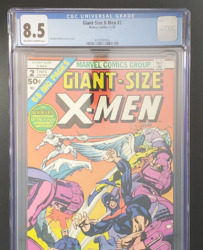
Giant-Size X-Men #2 CGC 8.5 1975 Marvel - Available NOW on ebay
Some Key X-Men Issues to Collect
The X-Men have a long and storied history in comic books, and there are several key issues that have had a significant impact on the characters and the X-Men franchise as a whole. Here are some notable and influential X-Men comic issues:
- "Giant-Size X-Men #1" (1975): This issue relaunched the X-Men series and introduced a new team of mutants that included Storm, Colossus, Nightcrawler, and Wolverine, among others. It revitalized the X-Men franchise and set the stage for its future success.
- "Uncanny X-Men #94-280" (1975-1991): This lengthy run of the "Uncanny X-Men" series, written by Chris Claremont, is considered one of the most important and influential in X-Men history. It featured major story arcs like the Phoenix Saga, Days of Future Past, and the Mutant Massacre.
- "X-Men #1" (1991): The launch of the second X-Men series, written by Chris Claremont and illustrated by Jim Lee, became one of the best-selling comic books of all time. It marked a new era for the X-Men and showcased a dynamic and visually striking art style.
- "Age of Apocalypse" (1995): This crossover event took place in multiple X-Men titles and presented an alternate reality where Professor X's son, Legion, went back in time to kill Magneto, resulting in a dystopian world ruled by Apocalypse. It had a significant impact on the X-Men mythos.
- "New X-Men #114" (2001): Grant Morrison's run on "New X-Men" brought a new direction and modernization to the X-Men. Issue #114 marked the start of his critically acclaimed run, which introduced new concepts, costume changes, and a focus on mutant evolution.
- "House of M" (2005): This event, written by Brian Michael Bendis, centered around Scarlet Witch altering reality and creating a world where mutants were the dominant species. It had far-reaching consequences for the X-Men and mutantkind.
- "X-Men: Messiah Complex" (2007-2008): This crossover event involved multiple X-Men titles and focused on the birth of the first mutant child since the "Decimation" event. It sparked a race between various factions to control the baby and became a pivotal moment in X-Men storytelling.
- "Uncanny X-Force #1" (2010): This series, written by Rick Remender, showcased a covert X-Force team that operated with a morally ambiguous mission. It explored darker themes and received critical acclaim for its storytelling and character development.
GET ALL THE MOST CURRENT INFO ON THE BEST BOOKS - First Appearances, Values, etc -- From the NEW EDITION OF THE OVERSTREET PRICE GUIDE
Read the full article
0 notes
Link
Check out this listing I just added to my Poshmark closet: The Comic Book Price Guide No. 13 Robert M. Overstreet Paperback Vintage 1983.
0 notes